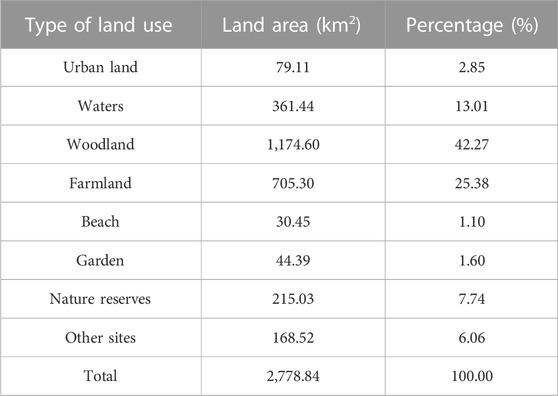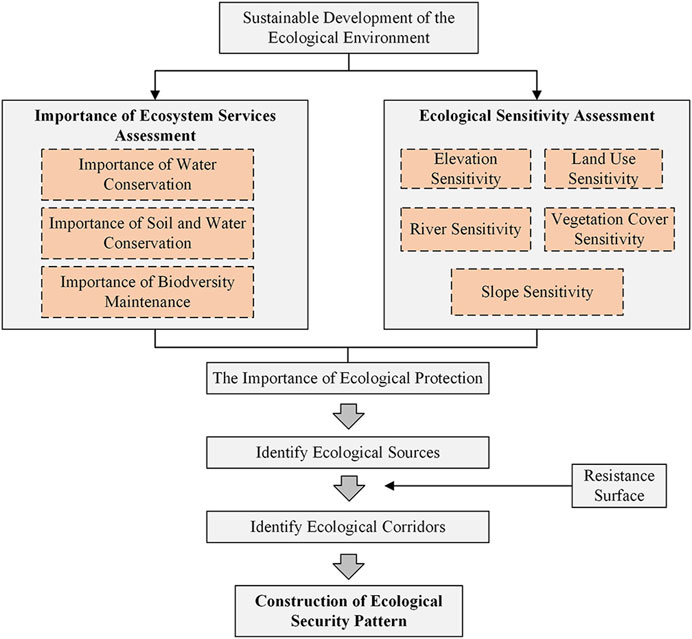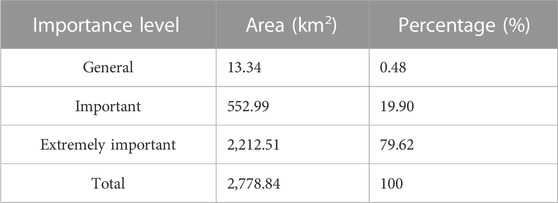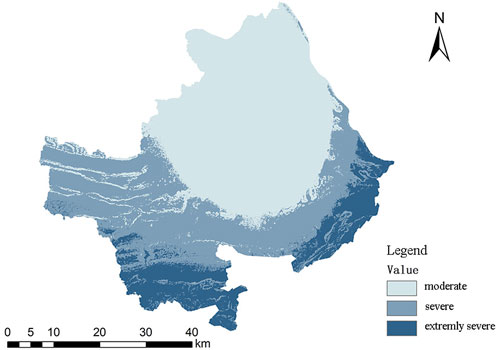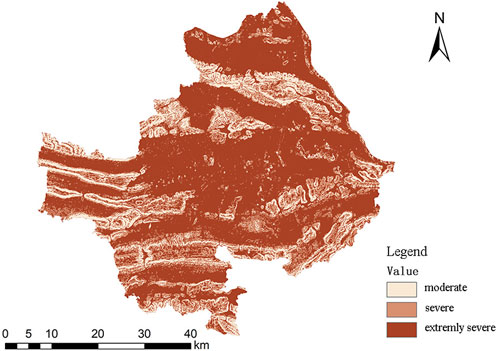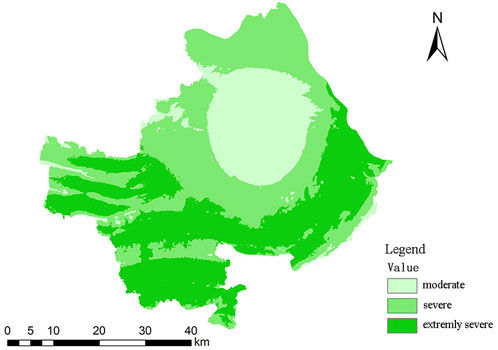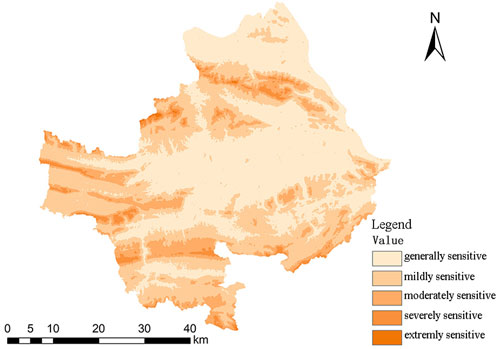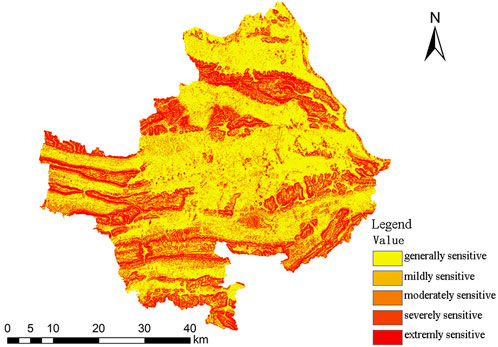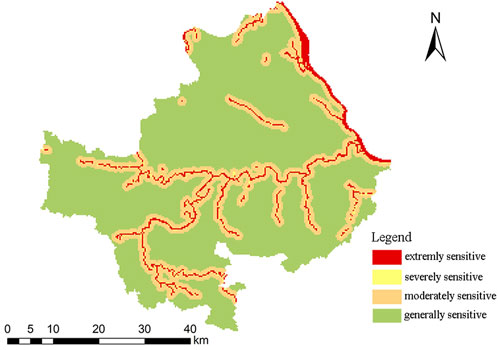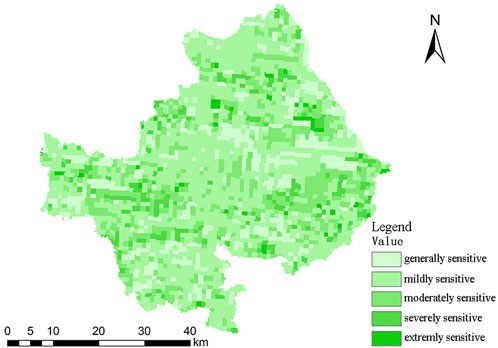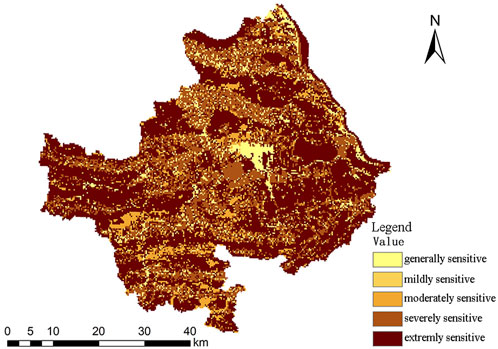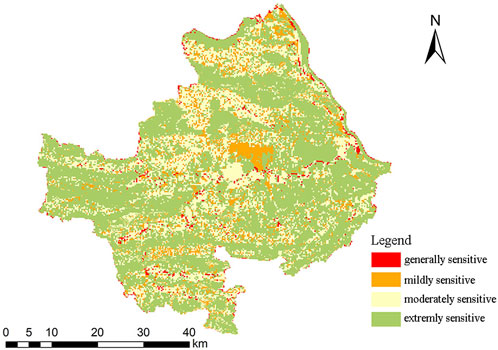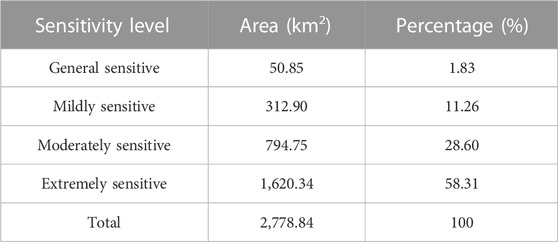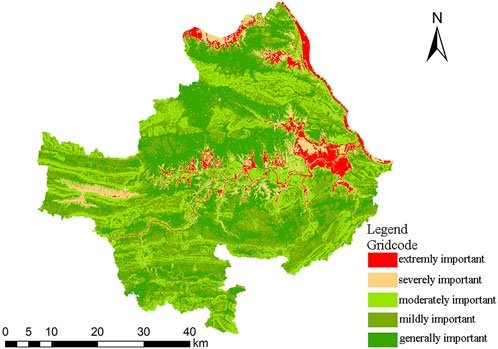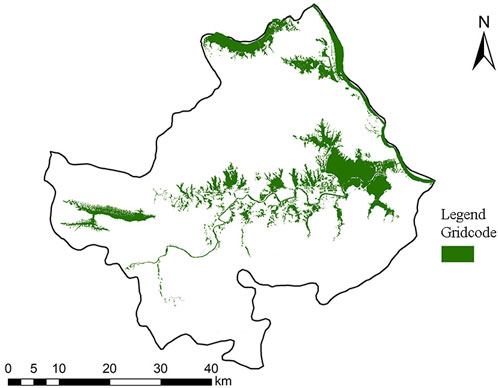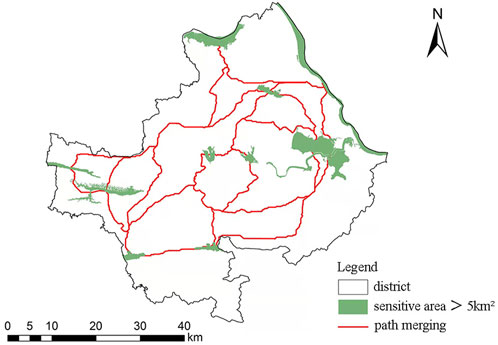- 1School of Urban Construction, Wuhan University of Science and Technology, Wuhan, China
- 2Hubei Provincial Engineering Research Center of Urban Regeneration, Wuhan University of Science and Technology, Wuhan, China
- 3School of Architecture and Urban Planning, Huazhong University of Science and Technology, Wuhan, China
- 4Hubei Engineering and Technology Research Center of Urbanization, Wuhan, China
An ecological safety pattern is the basic guarantee for pollution control, ecological environmental protection, economic construction, and sustainable social development, and is an important means of integrated and coordinated development, protection, and governance. This study proposes a research method to identify ecological source sites based on the evaluation of the importance of ecosystem services and ecological sensitivity, and to identify ecological corridors using the minimum cumulative resistance model. The empirical analysis was carried out in Yangxin County, Hubei Province, as an example. The results show that the study area has 16 key corridors and 29 potential corridors, a total of 45 ecological corridors, with a total length of 452 km. In addition, these ecological corridors present a network-like intertwined distribution, connecting various ecological source sites and ensuring the connectivity between ecological source sites, while the well-developed water source sites in the study area provide excellent ecosystem service functions such as water containment for the area.
1 Introduction
Rapid global and regional social economy development (Fang et al., 2020), on one hand, has promoted economic development and high-intensity urban construction (Zhang et al., 2019). On the other hand, it has also caused wastage of resources and ecological damage due to the excessive exploitation and utilization of natural resources (Sun and Zhang, 2021), leading to a continuous decline in the carrying capacity of resources and the environment (Su et al., 2019), which has become a major factor affecting and restricting social and economic development (Liu et al., 2016), and has severely restricted national security and human sustainable development in the context of globalization (Will et al., 2015). In order to promote the sustainable development of the ecological environment and natural resources (Moisen et al., 2020), the United Nations “Convention on Biological Diversity” has put forward restoration goals for degraded ecosystems (Lee et al., 2015). The Chinese government has also issued corresponding policies and put forward a new development concept centered on ecological civilization, which has achieved obvious results in some areas. However, from the perspective of the current overall ecological environment in China, ecological protection-related work still faces a severe situation.
Relying on the service functions of the ecosystem, humans can directly or indirectly obtain ecological products and services (Costanza et al., 1997; Loomes and O’Neill, 1997), whose functions include soil and water protection, water connotation, wind prevention and sand fixation, and biodiversity maintenance (Ouyang, 2017; Xiao et al., 2020), which are important promises for ecological stability and sustainable development (Xi et al., 2021). As the sustainable development of the ecological environment has received more and more attention, many studies have been carried out around ecosystem services (Costanza et al., 1997), estimating the value of global ecosystem services (Ouyang, et al., 1999a), providing guidance for subsequent related research (Howe et al., 2014), and sorting out relevant studies from 2000 to 2013 by systematic mapping (Zhang, et al., 2021). There are also numerous studies on different types of ecosystem services, such as terrestrial ecosystem service functions (Ouyang et al., 1999b; Fan et al., 2016; Shi et al., 2012), single ecosystem service functions in forests (Zhao et al., 2004a; Jin et al., 2005; Wang et al., 2007; Wang et al., 2011; Cui et al., 2019), rivers (Luan and Chen, 2004; Xiao et al., 2007; Xu et al., 2010; Xue, 2017), grasslands (Xie et al., 2001; Zhao et al., 2004b; Liu and Mou, 2012; Zhao et al., 2017), agricultural lands (Yang et al., 2005; Yin et al., 2006; Sun et al., 2007), wetlands (He et al., 2001; Xin and Xiao, 2002; Wu et al., 2008), and cities (Li et al., 2008; Zhao et al., 2013). For urban ecosystems, a more complete research system has been established with the efforts of many scholars, but this type of research still exists mostly in typical large cities and well-developed areas, and there are relatively few relevant studies for small towns in less developed areas in central China.
At present, there are still very serious ecological and environmental problems such as soil erosion, desertification, and sand and dust storms in some parts of the world (Ouyang et al., 2000), and the sustainability of the ecological environment as the basis of sustainable social and economic development has gradually reached a consensus (Yin et al., 2006). Currently, most of the relevant studies focus on a single ecological issue, such as the sensitivity analysis of soil erosion (Li et al., 2007; Fan et al., 2011; Sun et al., 2016), the sensitivity analysis of soil and ecosystems, and acid deposition (Chen et al., 1998; Gu and An, 2003; Peng and Wu, 2004); research studies seldom focus on integrated types of ecosystems. From the analysis of spatial scales of research, the relevant studies are mostly on macro-national (Hornung et al., 1995; Parikh, 2001; Shi and Liang, 2002), urban, and regional scales (Zhai et al., 2019), while there exist relatively few studies on the ecological sensitivity and related research on the county scale at the ordinary meso-level.
Ecological security is an important prerequisite for sustainable social development and has gradually become a hot research issue in recent years (Swart, 1996; Alcamo et al., 2001; Liu and Wang, 2010). The ecological security pattern originated from the landscape ecological security pattern proposed by Yu Kongjian in the 1990 (Yu, 1999). Early related studies mostly focused on biodiversity (Hess and Fischer, 2001). Since then, with the depth of research, a multidisciplinary intersection of ecological security pattern construction methods based on the ecological protection red line (Xu et al., 2015), ecosystem service supply and demand (Jing et al., 2018), source–sink theory (Wang et al., 2016), and ecosystem services (Han et al., 2019) has been gradually developed (Jpk et al., 1992). The minimum cumulative resistance model was proposed in 1992 as an important method for constructing an ecological security pattern. Since then, this method has been widely applied and improved and has been gradually established a “source-resistance surface-corridor” research paradigm.
Through the aforementioned literature review, it was found that there are many methods for constructing ecological security patterns, but most of them are carried out through a single methodological approach. Few scholars conduct research on the construction of ecological security patterns through methods similar to the integrated evaluation of ecosystem services and ecological sensitivity. On the other hand, related studies are mostly concentrated in the northwest and southeast coastal areas with relatively special ecological environments and typical large urban areas. There exist few studies on the central region and small town scale in China. Under the current background that the concept of ecological civilization guides urban development in China, it is quite essential to realize the ecological protection in the whole area and scale, so research on the construction of ecological security patterns in the central region and small towns is very valuable.
As a typical small town in central China, while Yangxin County is developing its economy at a high speed, ecological and environmental problems are also coming to the forefront, generating environmental problems such as environmental deterioration of water resources, soil erosion, and flooding, which has severely restricted the sustainable economic and social development. How to identify ecological source sites and ecological corridors and build ecological security patterns is the focus of ecological protection and restoration work in Yangxin County. Therefore, based on the summary and analysis of the existing studies on ecological security patterns, this paper selects Yangxin County as the study area and conducts the evaluation of the importance of ecosystem services and ecological sensitivity. Based on the evaluation results, ecological source sites are identified, and ecological corridors are identified using the minimum cumulative resistance model on this basis. Finally, based on the comprehensive analysis of natural resource characteristics in Yangxin County, the ecological security pattern of the “source land–corridor–network” is constructed based on ecological source land and ecological corridor, and corresponding ecosystem protection strategies are proposed to provide reference for ecological protection and restoration in the national land space.
2 Materials and methods
2.1 Study area
Yangxin County is located in central China, on the south bank of the middle reaches of the Yangtze River and the southeastern part of Hubei Province. The total land area is 2,778.84 km2, as shown in Figure 1, with abundant forested land and water resources, as shown in Table 1. Yangxin County has 45 km of the Yangtze River waterfront shoreline, with interwoven river and lake systems, such as the Xiandao Lake Ecological Tourism Scenic Area, Lotus Lake National Wetland Park, Net Lake Provincial Wetland Nature Reserve, and Daye Lake. Fushui crosses the east and west, connecting the Yangtze River and Fushui Reservoir. In addition, there are more than dozens of large and small peaks, such as the Qifeng Mountain Provincial Forest Park, with an altitude of 862.7 m, Father and Son Mountain, and Hengling Mountain. Yangxin County is located in the transition zone between mountains and plains, whose landscape features are typical of low mountainous hilly areas. As an important agricultural product base in Hubei Province, Yangxin County has a good ecosystem supply function. However, Yangxin has been developing high-polluting industries such as materials, mining, and metallurgical processing and non-ferrous metal processing, which, together with social development and construction, encroach on natural ecological space. The ecological environment has been severely damaged, the service capacity of the ecosystem has decreased sharply, and the ecological sensitivity has increased. Therefore, for Yangxin County, it is undoubtedly a very typical case to construct its ecological security pattern based on the significance of ecosystem services and ecological sensitivity and to provide references for Yangxin’s ecological governance and restoration work.
The data used in the study include land use data, NDVI vegetation index data, soil data, and administrative boundary data from the Resource and Environmental Science Data Center of the Chinese Academy of Sciences (http://www.resdc.cn/); 30-m resolution DEM data come from the geospatial data cloud (http://www.gscloud.cn/); the meteorological data come from the National Earth System Science Data Center, National Science and Technology Infrastructure of China (http://www.geodata.cn).
2.2 Method overview
In the context of ecological sustainable development, the study proposes a combination of two types of evaluation of the importance of ecosystem services and ecological sensitivity. Among them, the important evaluation of ecosystem services has three types of indicators, i.e., the importance of water protection, the importance of soil and water protection, and the importance of biodiversity conservation. The ecological sensitivity assessment has five types of indicators, i.e., elevation sensitivity, land use sensitivity, river sensitivity, vegetation cover sensitivity, and slope sensitivity. Through the superposition analysis, the results of ecological protection significance were obtained, and combined with the actual ecological status of Yangxin County, the heavily important and extremely important areas were selected as ecological source sites. The center of the ecological source area is extracted as the ecological node, the resistance surface is constructed by superimposing the selected factors, and the key corridors and potential corridors are identified. Finally, suggestions and conclusions on the construction of ecological security patterns are proposed. This research was carried out through the steps given in Figure 2.
2.3 Assessment of the importance of ecosystem services
According to the ecological pattern of “four screens, three rivers, and one district” in Hubei Province, Yangxin County is located in the Mufu Mountains in southeast Hubei Province, one of the four screens, close to the Yangtze River in the “Three Rivers,” and also contains the lake wetland referred to as the “One District,” which has a great advantage in water connotation service. Therefore, combining with the actual situation of investigation and analysis, the research focuses on water conservation, soil and water protection, and biodiversity maintenance.
Ecosystems can intercept, infiltrate, and accumulate precipitation, and also regulate the water cycle through evaporation and emission, which is the water protection function of ecosystems (Ding et al., 2019). The total amount of water conservation is the sum of total precipitation minus evapotranspiration and other consumption, calculated by Formula (1):
where TQ is the total amount of water conservation (
Soil and water protection is calculated by the RUSLE model. The amount of soil and water conservation is the difference between the potential soil erosion amount and the actual soil erosion amount (Jiang et al., 2015), calculated by Formula (2), Formula (3), and Formula (4):
where
Species diversity and genetic diversity together constitute biodiversity, which can be reflected by habitat quality. It can be calculated using the InVEST model, calculated by Formula (5):
where
2.4 Ecological sensitivity evaluation
With reference to relevant studies on ecological sensitivity evaluation (Han et al., 2008; Pan et al., 2011), combining with the characteristics of the natural environment in Yangxin County, the study selects five evaluation factors of elevation, slope, river, land use, and vegetation coverage, as shown in Table 2. According to the significance of each factor to the study area, the factor weights determined by the hierarchical analysis method are used to obtain the sensitivity assignment of each factor through the multi-factor weighted spatial superposition analysis method. The ecological sensitivity evaluation results are classified into five levels of “general sensitive area, mild sensitive area, moderate sensitive area, severe sensitive area, and extremely sensitive area.”
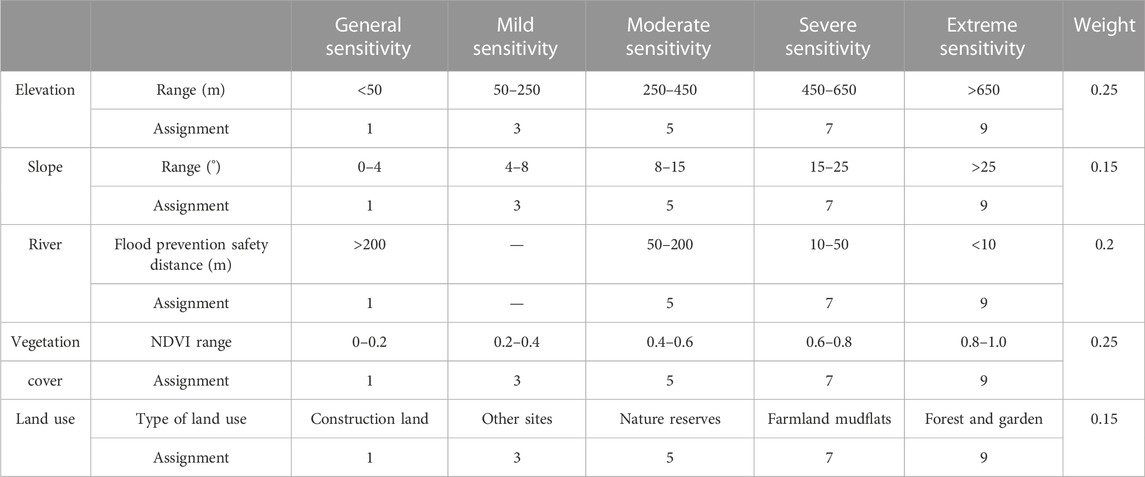
TABLE 2. Classification of ecological sensitivity evaluation factor weights and sensitivity assignment.
2.5 Construction of the minimum cumulative resistance model
Based on the minimum cumulative resistance model, the minimum cost path between the sources is calculated. This method was first proposed by Knaapen (Chen et al., 2003) and modified by Yu Kongjian et al. (Yu, 1999; Chen et al., 2003), and it is calculated by Formula (6):
where MCR is the minimum cumulative resistance value,
3 Results and analysis
3.1 Importance results of ecosystem services in Yangxin County
The spatial distribution of different ecosystem service types in Yangxin County is characterized by large differences and certain common features. The important and extremely important areas of water conservation are mainly distributed in the southern and western parts of Yangxin; this part of the area shows a more obvious differentiation phenomenon from the general area of water conservation. Areas with higher soil and water conservation services are mainly distributed in the middle of Yangxin and tend to be distributed along Qifeng Mountain, Dawang Mountain, Jinzhujian Mountain, and other mountain ranges. The areas with high values of biodiversity service are mainly distributed in the southern areas where the mountains are clustered and less disturbed by human activities, while the biodiversity in the central city and surrounding areas with more developed traffic is relatively low.
The results of the comprehensive evaluation of the importance of ecosystem services are given in Table 3, which show that the importance of ecosystem services in most areas of Yangxin is at a high level, among which, the total area of extremely important areas is 2,212.51 km2, accounting for 79.62% of the total land area of Yangxin, while areas with general importance of ecosystem services are scattered in the border areas of administrative regions, with a total area of 13.34 km2, accounting for 0.48% of the total land area. In summary, Yangxin County has good ecosystem service capacity and is one of the key areas of the ecological barrier in southeast of Hubei, which can provide good ecological functions for the surrounding areas shown in Figure 3, Figure 4, Figure 5, and Figure 6.
3.2 Ecological sensitivity results of Yangxin County
The single-factor evaluation results are superimposed to obtain the comprehensive evaluation results of ecological sensitivity, which are divided into four grades. The analysis results show that both the elevation and slope sensitivity are closely related to the distribution of mountains, and the high-sensitive areas are mainly distributed in the higher-altitude mountains, ridges, and other areas. The spatial distribution of river sensitivity shows a belt-like distribution along the river basin, and the areas with higher sensitivity are mainly along the Yangtze River and Fushui.
The total area of the extremely ecologically sensitive area in Yangxin County is 1,620.34 km2, accounting for 58.31% of the total land area, indicating that the Yangxin area has high ecological sensitivity and the ecological environment is susceptible to the influence of external environmental changes. Therefore, the economic development and construction of the region and its impact on the ecological environment should be considered comprehensively to promote the sustainable development of Yangxin County, as shown in Figure 7, Figure 8, Figure 9, Figure 10, Figure 11, and Figure 12, and Table 4.
3.3 Ecological source of Yangxin County
The results of the importance of ecological protection are obtained through superimposition analysis, and the heavily important and extremely important areas are selected as ecological sources by combining with the actual ecological condition of Yangxin County. A total of 11 ecological sources were obtained, with a total area of 188.88 km2, accounting for 6.8% of the total land area. The spatial distribution of these ecological sources shows two characteristics: first, they mainly distribute along the Yangtze River and Fushui in a belt-like pattern and concentrate in developed water system areas such as Daye Lake and Xiandao Lake; second, they are more concentrated in the dense areas of mountains with a better natural ecological environment such as Qifeng Mountain. Comparing the obtained ecological source area with the scope of the natural protected area shows that the ecological source area basically contains the natural protected area, indicating the scientific nature of the research method and the rationality of the evaluation results given in Figure 13 and Figure 14.
3.4 Ecological security pattern of Yangxin County
The center of the ecological source area is extracted as the ecological node, the resistance surface is constructed by superimposing land use, elevation, slope, road, etc., the least cost-consuming path between sources is extracted as the key corridors using cost-distance of ArcGIS, and the other corridors identified are taken as potential corridors. A total of 45 ecological corridors were identified, with a total length of 452 km, including 16 key corridors with a length of 168 km and 29 potential corridors with a length of 284 km. These ecological corridors ensure the convenience and connectivity between ecological sources and mainly distribute along river systems and mountain woodlands, as shown in Figure 15.
From the results of the construction of ecological security patterns, Yangxin County has a good ecological security network. Under the background of a new round of land and space planning and construction in the future, we should also pay more attention to the protection and implementation process of ecological security patterns, which can be strengthened from the following aspects.
3.5 Strengthening the construction of ecological protection systems
This study can, to a certain extent, guide the construction of ecological protection and restoration patterns of national land space and help solve the serious challenges faced by the current ecological protection and restoration system project of national land space (Fang et al., 2020); it is also important to maintain the integrity of the landscape pattern and regional ecological security (Chen et al., 2016b; Peng et al., 2017).
Based on the analysis of the research results, this paper proposes the establishment of a multi-party participation and whole life cycle ecological protection system and coordinates with the whole process of planning, construction, and management. The ecological protection cooperation with surrounding areas must be strengthened, and an ecological protection system of “whole region, joint governance, joint construction, and sharing” must be formed.
3.5.1 Improving the fund guarantee of ecological engineering
On one hand, we should ensure the support of special funds for ecological protection, strengthen the support of national policies such as the construction of ecological civilization for regional ecological protection, and establish a national provincial city county multi-level ecological protection fund guarantee system. On the other hand, through ecological restoration and governance, we must enhance the regional ecosystem GDP, strengthen the value transformation of ecological products and ecosystem services, and realize the “hematopoiesis” of funds.
3.5.2 Optimizing the implementation mechanism of ecological protection
We should effectively connect major ecological restoration and protection projects with provincial, city, and county land spatial planning, and implement the construction of a regional ecological security pattern at different levels. At the same time, the key indicators of the ecological security pattern will be incorporated into the index system of urban physical examination and the index system of planning implementation evaluation, and the construction of the ecological security pattern will be subject to regular dynamic physical examination and evaluation.
3.5.3 Strengthening cooperation with neighboring regions in ecological protection and restoration
We should strengthen the ecological protection and restoration cooperation between Yangxin County and Daye City, Xianning City, Wuhan City, and other areas, and jointly plan large-scale regional ecosystem protection and restoration projects with the support of the provincial government. At the regional level, it forms a demonstration area of ecological governance with a “benign interaction and win–win cooperation.” At the same time, ecological management at the regional level can help achieve systematic management of important mountains and water systems, such as the Yangtze River and Fushui River, and the Mufu Mountains and other important mountains.
3.5.4 Implementing special protection for key ecological sources and corridors
According to the identification results of ecological source sites and corridors in Yangxin County, their main characteristics are distributed along mountains and water systems, so the focus should be on these types of ecological source sites and corridors when formulating ecological protection and restoration policies. In particular, ecological source sites and corridors along the Yangtze River, Fushui distribution, and around Xiandao Lake should be prioritized for protection and restoration during the implementation of ecological management.
4 Discussion and conclusion
Yangxin County, as an important part of the ecological barrier in the southeast of Hubei Province in the ecological protection of “four screens, three rivers, and one district,” has a high-quality ecological environment, but with the expansion of urban development, the regional ecological sensitivity is increasing and needs to be protected urgently. The study identifies ecological sources using the comprehensive evaluation results of the importance of ecosystem services and ecological sensitivity, building resistance surfaces, identifies ecological corridors using the minimum cumulative resistance model, and constructs ecological security patterns. The conclusions are as follows:
(1) The study identified 188.88 km2 of ecological sources in Yangxin County, accounting for 6.8% of the total land area. The ecological sources are mainly rivers and lakes, followed by important forest reserves, mountains, etc. As a typical landscape city, Yangxin County has an excellent ecological service capacity of water conservation, and the Zhupo Lake Flower Fish Bone National Aquatic Germplasm Resource Reserve in the territory was selected as the sixth batch of national aquatic germplasm resource reserves.
(2) The study identifies 16 key corridors and 29 potential corridors, a total of 45 ecological corridors, with a total length of 452 km. These ecological corridors are interwoven in a network pattern, connecting various ecological sources and guaranteeing the connectivity between them.
The study constructs ecological security patterns by means of quantitative analysis and evaluation, which can provide effective ideas to solve ecological security problems for the ongoing work of territorial spatial planning and the related work of territorial spatial ecological restoration and ecological management. At the same time, this study can also provide a reference for the ecological control and management of Yangxin County and the surrounding areas with similar situations, and promote the steady improvement of regional ecological environmental protection and sustainable social development. Finally, some problems of this paper need to be pointed out: the evaluation methods of ecosystem service importance and ecological sensitivity used in the study need to be further improved; the study identifies ecological source sites and ecological corridors, but more in-depth research is needed on how to optimize the break points and ecological barrier points between ecological corridors. The key technologies for ecological safety pattern construction need to be further researched in order to achieve better ecological protection and restoration effects.
Data availability statement
The original contributions presented in the study are included in the article/Supplementary Material; further inquiries can be directed to the corresponding author.
Author contributions
HX: conceptualization, funding acquisition, writing—review and editing, and supervision. ZZ: conceptualization, data curation, methodology, visualization, writing—original draft, and formal analysis. TL: writing—review and editing and supervision. XY: writing—review and editing. ZC: writing—review and editing. All authors contributed to the article and approved the submitted version.
Funding
This research was funded by the National Natural Science Foundation of China (No. 41771473) and the Hubei Research Project on the Construction of Yangtze River National Cultural Park (No. HCYK 2022Y20).
Conflict of interest
The authors declare that the research was conducted in the absence of any commercial or financial relationships that could be construed as a potential conflict of interest.
Publisher’s note
All claims expressed in this article are solely those of the authors and do not necessarily represent those of their affiliated organizations, or those of the publisher, the editors, and the reviewers. Any product that may be evaluated in this article, or claim that may be made by its manufacturer, is not guaranteed or endorsed by the publisher.
References
Alcamo, J., En De Jan, M. B. F., Kaspar, F., and Rösch, T. (2001). The GLASS model: A strategy for quantifying global environmental security. Environ. Sci. Policy 4, 1–12. doi:10.1016/s1462-9011(00)00099-x
Chen, D. M., Xie, S. D., and Hu, Y. T. (1998). Evaluation methods and progress of ecosystem sensitivity to acid deposition. Environ. Sci. 05, 93–97. doi:10.13227/j.hjkx.1998.05.026
Chen, L. D., Fu, B. J., Xu, J. Y., and Gong, J. (2003). A method of landscape pattern identification based on the "source-sink" ecological process-landscape spatial load contrast index. Acta Ecol. Sin. 11, 2406–2413. doi:10.3321/j.issn:1000-0933.2003.11.025
Chen, Y., Ha, K., He, W. L., Zhang, H., Li, X. Q., and Chen, G. (2016b). Study on the change and optimization of landscape pattern in the basin of northwest hebei mountains: A case study of huailai county, hebei province. J. Nat. Resour. 31 (4), 556–560. doi:10.3760/cma.j.issn.0529-5807.2016.08.012
Chen, Y., Qiao, F., and Jiang, L. (2016a). Research on the impact of land use pattern changes on regional scale habitat quality based on in VEST model: Taking beijing as an example. J. Peking Univ. Nat. Sci. Ed. 52 (03), 553–562. doi:10.13209/j.0479-8023.2016.057
Costanza, R., d’ Arge, R., De Groot, R., Farberk, S., Belt, M. V. D., Hannon, B., et al. (1997). The value of the world’s ecosystem services and natural capital. Nature 387, 253–260. doi:10.1038/387253a0
Cui, Y. Q., Fan, L. Y., and Liu, S. C. (2019). Evaluation of forest ecosystem service function in Shanxi Province. Acta Ecol. Sin. 39 (13), 4732–4740. doi:10.5846/stxb201807091493
Ding, X. X., Zhu, T., Zhu, J., Xing, Y., and Chang, X. Y. (2019). Analysis of shenzhen ecosystem water conservation function based on water balance equation. Environ. Prot. Circular Econ. 39 (01), 26–30. doi:10.3969/j.issn.1674-1021.2019.01.010
Fan, F. D., Wang, K. L., Xiong, Y., Xuan, Y., Zhang, W., and Yue, Y. M. (2011). Sensitivity evaluation of soil erosion in Southwestern Karst region and its spatial differentiation characteristics. Acta Ecol. Sin. 31 (21), 6353–6362.
Fan, Y. L., Hu, N., Ding, S. Y., Liang, G. F., and Lu, X. L. (2016). Research progress on terrestrial ecosystem services and biodiversity. Acta Ecol. Sin. 36 (15), 4583–4593. doi:10.5846/stxb201501050028
Fang, Y., Wang, J., Huang, L. Y., and Zhai, T. L. (2020). Diagnosis and identification of key areas of land and space ecological protection and restoration based on ecological security pattern—taking yantai city as an example. J. Nat. Resour. 35 (01), 190–203. doi:10.31497/zrzyxb.20200116
Gu, H. Y., and An, Y. L. (2003). The relative sensitivity of Guizhou Province's ecosystem to acid deposition. J. Guizhou Normal Univ. Nat. Sci. Ed. 04, 88–91. doi:10.16614/j.cnki.issn1004-5570.2003.04.023
Han, G., Zhao, K., and Yuan, X. (2008). Evaluation of ecological sensitivity in mountain area based on spatial analysis—a case study of wanyuan city in sichuan province. J. Mt. Sci. 5, 531–537. doi:10.3969/j.issn.1008-2786.2008.05.004
Han, Z. L., Zhao, W. Z., Yan, X. L., Zhong, J. Q., and Meng, Q. Q. (2019). Analysis on the evolution of ecological security pattern based on the value gains and losses of ecosystem services—taking wafangdian city along the coast of liaoning as an example. Chin. J. Ecol. Sci. 39 (22), 8370–8382. doi:10.5846/stxb201809071916
He, C. Q., Cui, B. S., and Zhao, Z. C. (2001). Ecological evaluation of typical wetlands in Jilin Province. J. Appl. Ecol. 12 (05), 754–756. doi:10.13287/j.1001-9332.2001.0180
Hess, G. R., and Fischer, R. A. (2001). Communicating clearly about conservation corridors. Landsc. Urban Plan. 55, 195–208. doi:10.1016/s0169-2046(01)00155-4
Hornung, M., Bull, M., Cresser, D., Hall, J., and Langan, S. (1995). The sensitivity of surface waters of Great Britain to acidification predicted from catchment characteristics. Environ. Pollut. 87, 207–214. doi:10.1016/0269-7491(94)P2608-C
Howe, C., Suich, H., Vira, B., and Mace, G. M. (2014). Creating win-wins from trade-offs? Ecosystem services for human well-being: A meta-analysis of ecosystem service trade-offs and synergies in the real world. Glob. Environ. Change 28, 263–275. doi:10.1016/j.gloenvcha.2014.07.005
Jiang, C. L., Zhang, L. J., Zhang, H. W., Jiang, C. Y., Yu, Y., and Pan, T. (2015). Evaluation of soil conservation in Heilongjiang Province from 2000 to 2010 based on RUSLE model. Chin. J. Eco-Agriculture 23 (05), 642–649. doi:10.13930/j.cnki.cjea.141320
Jin, F., Lu, S. W., and Yu, X. X. (2005). China's forest ecosystem service function and its value evaluation. J. Appl. Ecol. 16 (08), 1531–1536. doi:10.13287/j.1001-9332.2005.0190
Jing, Y. C., Chen, L. D., and Sun, R. H. (2018). A framework for the construction of the ecological security pattern of urban agglomerations based on the supply and demand of ecosystem services. Acta Ecol. Sin. 38 (12), 4121–4131. doi:10.5846/stxb201803090469
Jpk, A., Ms, B., and Bh, A. (1992). Estimating habitat isolation in landscape planning. Landsc. Urban Plan. 23, 1–16. doi:10.1016/0169-2046(92)90060-D
Lee, B. X., Kjaerulf, F., Turner, S., Cohen, L., Donnelly, P. D., Muggah, R., et al. (2015). Transforming our world: Implementing the 2030 agenda through sustainable development goal indicators. J. Public Health Policy 1, 13–31. doi:10.1057/s41271-016-0002-7
Li, W. K., Li, T. H., and Qian, Z. H. (2008). The impact of land use changes in Shenzhen on ecological service functions. J. Nat. Resour. 23 (03), 440–446. doi:10.3321/j.issn:1000-3037.2008.03.010
Li, Y. B., Shao, J. A., Wang, S. J., and Li, R. B. (2007). Sensitivity evaluation of soil erosion based on the characteristics of karst ecosystems. J. Mt. Res. 06, 671–677. doi:10.3969/j.issn.1008-2786.2007.06.005
Liu, F. Y., and Wang, S. K. (2010). Ecological safety evaluation of land use in ji'an city based on the principal component analysis. Asian Agric. Res. 38 (11), 5788–5790+5809. doi:10.13989/j.cnki.0517-6611.2010.11.188
Liu, S., Dong, Y., Cheng, F., Coxixo, A., and Hou, X. (2016). Practices and opportunities of ecosystem service studies for ecological restoration in China. Sustain Sci. 11, 935–944. doi:10.1007/s11625-016-0390-4
Liu, X. Y., and Mou, Y. T. (2012). Research progress on grassland ecosystem service function and its value evaluation. Acta Prataculturae Sin. 21 (06), 286–295.
Loomes, R., and O’Neill, K. (1997). Nature’s services: Societal dependence on natural ecosystems. Pac. Conserv. Biol. 6, 274–221. doi:10.1071/pc000274
Luan, J. G., and Chen, W. X. (2004). Typical characteristics and service functions of river ecosystems. People's Yangtze River 35 (09), 41–43. doi:10.16232/j.cnki.1001-4179.2004.09.016
Moisen, G. G., McConville, K. S., Schroeder, T. A., Healey, S. P., Finco, M. V., and Frescino, T. S. (2020). Estimating land use and land cover change in north Central Georgia: Can remote sensing observations augment traditional forest inventory data? Forests 11, 856. doi:10.3390/f11080856
Ouyang, Z. Y. (2017). The problems and countermeasures facing my country's ecological system. China Natl. Cond. Natl. Power 03, 6–10. doi:10.13561/j.cnki.zggqgl.2017.03.002
Ouyang, Z. Y., Wang, R. S., and Zhao, J. Z. (1999a). Ecosystem service function and its ecological economic value evaluation. J. Appl. Ecol. 05, 635–640. doi:10.13287/j.1001-9332.1999.0166
Ouyang, Z. Y., Wang, X. K., and Miao, H. (1999b). A preliminary study on the service function of China's terrestrial ecosystem and its ecological economic value. Acta Ecol. Sin. 05, 19–25.
Ouyang, Z. Y., Wang, X. K., and Miao, H. (2000). Research on the sensitivity of China's ecological environment and its regional differences. Acta Ecol. Sin. 01, 10–13. doi:10.3321/j.issn:1000-0933.2000.01.002
Pan, F., Tian, C., and Feng, S. (2011). Evaluation of ecological sensitivity in Karamay,Xinjiang, northwest China. Acta Geoaphica Sin. 66 (11), 1497–1507. doi:10.11821/xb201111006
Parikh, K. J., and Parikh, J. (2001). Indian agriculture and climate sensitivity. Glob. Environ. Change 11, 147–154. doi:10.1016/S0959-3780(01)00004-8
Peng, J., Zhao, H. J., and Liu, Y. X. (2017). Research progress and prospect on regional ecological security pattern construction. Geogr. Res. 36 (3), 407–419. doi:10.11821/dlyj201703001
Peng, S. L., and Wu, F. C. (2004). Regionalization of the relative sensitivity of Hunan soil ecosystem to acid deposition. Trop. Geogr. 01, 10–13. doi:10.3969/j.issn.1001-5221.2004.01.003
Shi, D. M., and Liang, Y. (2002). Assessment and protection of fragile ecological environment in my country. J. Soil Water Conservation 01, 6–10. doi:10.13870/j.cnki.stbcxb.2002.01.002
Shi, Y., Wang, R. S., Huang, J. L., and Yang, W. R. (2012). Analysis of the spatiotemporal changes in the service functions of China's terrestrial ecosystems. Chin. Sci. Bull. 57 (09), 720–731. doi:10.1007/s11434-012-4978-5
Su, C., Dong, J. Q., Ma, Z. G., Qiao, N., and Peng, J. (2019). Identification of priority areas for ecological protection and restoration of mountains, waters, forests, fields, lakes and grasses based on the pattern of ecological security—taking huaying mountain in sichuan province as an example. J. Ecol. Sci. 39 (23), 8948–8956. doi:10.5846/stxb201906111229
Sun, X. T., Zhou, Z. F., Chen, Q., Chen, J. J., and Zhang, S. S. (2016). Evaluation and distribution of soil erosion sensitivity in key ecological function areas: Taking Leishan County in Guizhou Province as an example. J. Soil Water Conservation 30 (06), 73–78+133. doi:10.13870/j.cnki.stbcxb.2016.06013
Sun, X., and Zhang, Z. (2021). Coupling and coordination level of the population, land, economy, Ecology and society in the process of urbanization: Measurement and spatial differentiation. Sustainability 13, 3171. doi:10.3390/su13063171
Sun, X. Z., Zhou, H. L., and Xie, G. D. (2007). The service function and economic value of China's farmland ecosystem. China Population. Resour. Environ. 17 (04), 55–60. doi:10.3969/j.issn.1002-2104.2007.04.012
Swart, R. (1996). Security risks of global environmental changes. Glob. Environ. Change Guildf. 6, 187–192. doi:10.1016/0959-3780(96)00014-3
Wang, B., Li, S. L., and Guo, H. (2007). Research on the service function and value evaluation of forest ecosystem in jiangxi province. Jiangxi Sci. 25 (05), 553–559. doi:10.13990/j.issn1001-3679.2007.05.018
Wang, B., Ren, X. X., and Hu, W. (2011). China's forest ecosystem service function and its value evaluation. For. Sci. 47 (02), 145–153. doi:10.11707/j.1001-7488.20110220
Wang, Q., Fu, M. D., Wei, L., Han, Y., Shi, N. N., Li, J. S., et al. (2016). The construction of urban ecological security pattern based on the source-sink theory and the least cumulative resistance model-Taking Ningguo City, Anhui Province as an example. Acta Sci. Circumstantiae 36 (12), 4546–4554. doi:10.13671/j.hjkxxb.2016.0167
Will, S., Katherine, R., and Rockström, J. (2015). Sustainability. Planetary boundaries: Guiding human development on a changing planet. Science 13 (6223), 1259855. doi:10.1126/science.1259855
Wu, Y., Jie, C., and Xu, B. (2008). Ecosystem service value assessment for constructed wetlands: A case study in hangzhou, China. Ecol. Econ. 68, 6–125. doi:10.1016/j.ecolecon.2008.02.008
Xi, H., Cui, W., Cai, L., Chen, M., and Xu, C. (2021). Evaluation and prediction of ecosystem service value in the zhoushan islands based on LUCC. Sustainability 13, 2302. doi:10.3390/su13042302
Xiao, J. H., Shi, G. Q., and Mao, C. M. (2007). Impact assessment of dams on river ecosystem service functions. Acta Ecol. Sin. 02, 526–537. doi:10.3321/j.issn:1000-0933.2007.02.014
Xiao, Y., Zhou, X., Jiang, X., Zhang, J., and Li, H. G. (2020). Research on the maintenance of ecological security pattern in Guiyang based on the evaluation of ecosystem service function. Ecol. Sci. 39 (04), 244–251. doi:10.14108/j.cnki.1008-8873.2020.04.030
Xie, G. D., Zhang, Y. L., and Lu, C. X. (2001). Ecosystem service value of natural grassland in China. J. Nat. Resour. 16 (01), 47–53. doi:10.3321/j.issn:1000-3037.2001.01.009
Xin, K., and Xiao, D. L. (2002). Estimation of service function value of wetland ecosystem in Panjin area. Acta Ecol. Sin. 22 (08), 1345–1349. doi:10.3321/j.issn:1000-0933.2002.08.025
Xu, D. L., Zou, C. X., Xu, M. J., You, G. Y., and Wu, D. (2015). Ecological security pattern construction based on ecological protection redlines. Biodiversity 23 (06), 740–746. doi:10.17520/biods.2015132
Xu, Y. F., Dong, J., and Duan, Y. F. (2010). Ecological restoration of river ecosystem service function degradation. Anhui Agric. Sci. 38 (01), 320–323. doi:10.13989/j.cnki.0517-6611.2010.01.031
Xue, Z. B. (2017). Evaluation of ecosystem service functions in the Yanhe River Basin based on InVEST model [D]. Shaanxi: Shaanxi Northwest University.
Yang, Z. X., Zheng, D. W., and Wen, H. (2005). Evaluation of the service function value of farmland ecosystem in Beijing suburbs. J. Nat. Resour. 20 (04), 564–571. doi:10.3321/j.issn:1000-3037.2005.04.012
Yin, F., Mao, R. Z., Fu, B. J., and Liu, G. (2006a). Farmland ecosystem service and its formation mechanism. Chin. J. Appl. Ecol. 17 (05), 929–934. doi:10.13287/j.1001-9332.2006.0186
Yin, H. W., Xu, J. G., Chen, C. Y., and Kong, F. H. (2006b). GIS-based ecological sensitivity analysis of the eastern Wujiang area. Geogr. Sci. 01, 64–69. doi:10.3969/j.issn.1000-0690.2006.01.011
Yu, K. J. (1999). Landscape ecological security pattern of biological protection. Acta Ecol. Sin. 01, 10–17. doi:10.3321/j.issn:1000-0933.1999.01.002
Zhai, D. Q., Ye, Q., and He, W. Q. (2019). Evaluation of land ecological sensitivity and optimization of landscape ecological pattern in hunan hilly cities. Chin. Landsc. Archit. 35 (01), 133–138. doi:10.3969/j.issn.1000-6664.2019.01.025
Zhang, S. D., Li, M. Y., Xiang, H. X., Wang, Z. M., and Yu, Y. (2021). Research on the balance and coordination of ecosystem services in the Liaohe River Basin. J. Agric. Sci. Yanbian Univ. 43 (01), 73–83. doi:10.13478/j.cnki.jasyu.2021.01.011
Zhang, Y., Sun, F. F., Chen, L., Li, G. D., and Wang, J. R. (2019). Investigation and analysis of public ecological civilization consciousness in rapid urbanization areas—taking baoan district of shenzhen as an example. Environ. Sustain. Dev. 44 (05), 143–146. doi:10.19758/j.cnkj.issn1673-288x.201905143
Zhao, D., Li, F., and Wang, R. S. (2013). Effects of land use change on ecosystem service value: A case study in huaibei city, China. Acta Ecol. Sin. 33 (08), 2343–2349. doi:10.5846/stxb201204120516
Zhao, M. M., Zhao, H. F., and Li, R. Q. (2017). Evaluation of grassland ecosystem service function value in Qinghai Province from 1998 to 2012. J. Nat. Resour. 32 (03), 418–433. doi:10.11849/zrzyxb.20160421
Zhao, T. Q., Ouyang, Z. Y., and Jia, L. Q. (2004b). Indirect value evaluation of service functions of grassland ecosystem in China. Acta Ecol. Sin. 24 (06), 1101–1110. doi:10.3321/j.issn:1000-0933.2004.06.002
Keywords: ecosystem service, ecological sensitivity, ecological protection pattern, comprehensive evaluation, Yangxin County
Citation: Xu H, Zhang Z, Yu X, Li T and Chen Z (2023) The construction of an ecological security pattern based on the comprehensive evaluation of the importance of ecosystem service and ecological sensitivity: a case of Yangxin County, Hubei Province. Front. Environ. Sci. 11:1154166. doi: 10.3389/fenvs.2023.1154166
Received: 01 February 2023; Accepted: 14 June 2023;
Published: 26 June 2023.
Edited by:
Corrado Battisti, Roma Tre University, ItalyCopyright © 2023 Xu, Zhang, Yu, Li and Chen. This is an open-access article distributed under the terms of the Creative Commons Attribution License (CC BY). The use, distribution or reproduction in other forums is permitted, provided the original author(s) and the copyright owner(s) are credited and that the original publication in this journal is cited, in accordance with accepted academic practice. No use, distribution or reproduction is permitted which does not comply with these terms.
*Correspondence: Zhiqi Zhang, bTIwMjI3NzEwN0BodXN0LmVkdS5jbg==
 Hong Xu
Hong Xu Zhiqi Zhang
Zhiqi Zhang Xincan Yu1
Xincan Yu1 Tianyue Li
Tianyue Li
